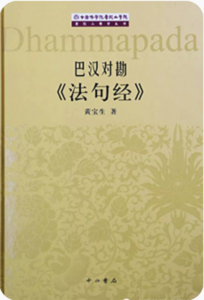
Huang Baosheng (黄宝生)
Shanghai, Zhongxi Book Company, 2015.
Reviewed by Yilan Chen (Ph.D. candidate of Peking University, HYI Visiting Fellow)
A Chinese-Pali Comparative Edition of the Dhammapada was conducted by Huang Baosheng (黄宝生), a prominent Chinese Indologist and Sanskrit scholar, and was published by Zhongxi Book Company in Shanghai in 2015. This new edition of the Dhammapada is mainly based on the Pali version of the Dhammapada and its early third century’s Chinese version by Vighna (维祇难). It’s also the first complete translation of the Dhammapada into modern Chinese. It is worth mentioning that the Dhammapada, as an early Buddhist collection of aphoristic verses compiled from various scriptures in the Buddhist canon, has been very popular in China and has been translated into traditional Chinese several times since it was firstly introduced into China in 224 BC[1]. This is mainly due to its profound philosophical and artistic language. Totaling 423 verses with twenty-six different themes, the aphorisms encapsulate fundamental Buddhist teachings and contain universally applicable principles of life philosophy and ethical instruction. Therefore, with its concise language full of vivid metaphors, it was readily accepted and became one of the most influential Buddhist texts in China.
The format of this new comparative edition initially lists the original Pali text based on the edition compiled by O. von Hinüber and K. R. Norman[2]. Subsequently, a modern Chinese translation for each verse is provided by Huang Baosheng. Then the traditional Chinese version by Vighna based on “Zhonghua Dazangjing”(《中华大藏经》) is appended. All these are accompanied by a critical apparatus of the text to address textual variations across different versions of the Dazangjing, selecting plausible readings in light of the Chinese-Pali comparison, which are then detailed in the annotations. Just as the translator has pointed out, the language of the Dhammapada is not abstruse though, translating Buddhist scriptures is a task that requires accumulated experience. The early Chinese translations of the Dhammapada have deficiencies that may cause difficulties in understanding the real meaning of the text. Through comparative textual criticism and detailed annotations, many ambiguities and difficult interpretations can be elucidated, thus allowing readers to grasp the meanings more accurately.
It is also noteworthy that Huang Baosheng is one of most distinguished translators of ancient Indian literature in modern China, having contributed a good numbers of excellent Chinese translations of ancient Indian works, including the Indian epic Mahābhārata. He also possesses an extensive knowledge and a deep understanding of classical Indian poetic theories. All these are reflected in A Chinese-Pali Comparative Edition of the Dhammapada. Therefore, this work holds a good academic value not only in Buddhist studies and the history of Buddhism but also in the realms of Indian literature and philology.
[1] Itsu Maki, “On the Chinese dhammapada with special reference to the preface attached thereto”. In The Annals of the Hitotsubashi Academy, Vol. 9, No. 1 (October 1958): 109-121.
[2] O. von Hinüber and K.R. Norman, eds. Dhammapada. Oxford: The Pali Text Society, 1995.
